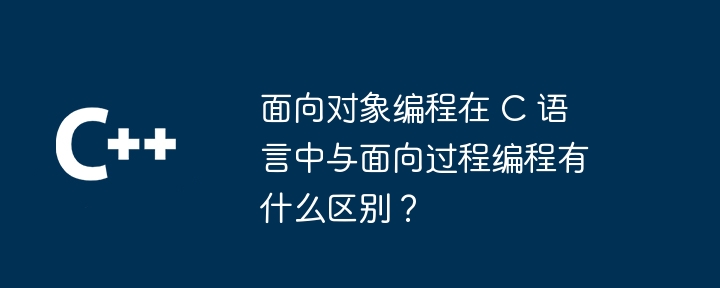c 语言中,面向对象编程 (oop) 与面向过程编程 (pop) 的区别在于: oop 专注于创建和操纵对象,而 pop 侧重于分解问题为一系列步骤。oop 优势包括可重用性、可维护性和可扩展性。pop 劣势则包括可重用性低、可维护性差和可扩展性差。实战案例中,oop 方法将矩形封装在类中,提供了设置维度、计算面积和周长的接口。

面向对象编程与面向过程编程在 C 语言中的区别
面向过程编程 (POP) 专注于分解问题为一系列步骤,而 面向对象编程 (OOP) 则围绕创建和操纵对象。
对象 是封装了数据和行为的实体。它们包含:
- 数据成员: 存储对象状态的信息
- 成员函数: 对对象数据进行操作的函数
类 是对象的蓝图,定义了对象的数据成员和成员函数。
OO 设计原则
- 封装: 隐藏对象的实现细节,只暴露必要的接口。
- 继承: 允许新类从现有类继承数据和行为。
- 多态: 允许对象响应相同的函数调用以不同的方式行为。
OO 优势
- 可重用性: 可以轻松地创建新对象,并继承来自现有类的行为。
- 可维护性: 更容易理解和维护代码,因为对象将职责清晰地分隔。
- 可扩展性: 可以轻松地添加新功能,而无需修改现有代码。
POP 劣势
- 可重用性低: 难以将 POP 代码模块化并重用于不同的项目。
- 可维护性差: 代码结构混乱,难以理解和维护。
- 可扩展性差: 添加新功能通常需要大量代码修改。
实战案例
考虑一个计算矩形的面积和周长的程序。
POP 方法:
#include <stdio.h> int main() { int length, width; printf("Enter length: "); scanf("%d", &length); printf("Enter width: "); scanf("%d", &width); int area = length * width; int perimeter = 2 * (length + width); printf("Area: %dn", area); printf("Perimeter: %dn", perimeter); return 0; }
登录后复制
OOP 方法:
#include <stdio.h> class Rectangle { private: int length, width; public: void setDimensions(int len, int w) { length = len; width = w; } int getArea() { return length * width; } int getPerimeter() { return 2 * (length + width); } }; int main() { Rectangle rectangle; int len, w; printf("Enter length: "); scanf("%d", &len); printf("Enter width: "); scanf("%d", &w); rectangle.setDimensions(len, w); printf("Area: %dn", rectangle.getArea()); printf("Perimeter: %dn", rectangle.getPerimeter()); return 0; }
登录后复制
在 OOP 方法中,矩形被封装在类中,该类提供了设置维度、计算面积和周长的接口。
以上就是面向对象编程在 C 语言中与面向过程编程有什么区别?的详细内容,更多请关注php中文网其它相关文章!
 微信扫一扫打赏
微信扫一扫打赏
 支付宝扫一扫打赏
支付宝扫一扫打赏

